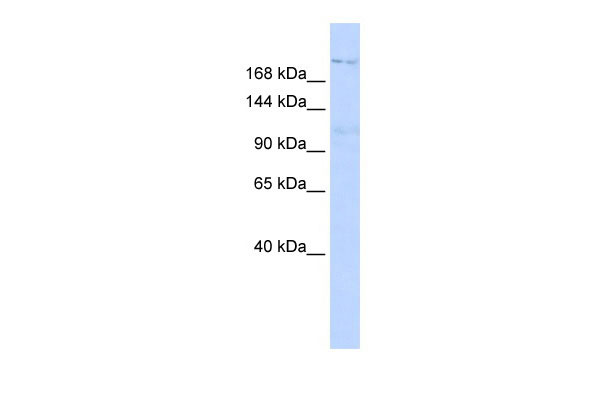INADL antibody - N-terminal region
Rabbit Polyclonal Antibody
- 产品详情
- 实验流程
Application
| WB |
|---|---|
| Primary Accession | Q8NI35 |
| Other Accession | NM_176877, NP_795352 |
| Reactivity | Human, Mouse, Rat, Rabbit, Dog, Guinea Pig, Horse, Bovine |
| Predicted | Human, Mouse, Rat, Rabbit, Guinea Pig, Horse, Bovine |
| Host | Rabbit |
| Clonality | Polyclonal |
| Calculated MW | 196368 Da |
| Gene ID | 10207 |
|---|---|
| Alias Symbol | Cipp, FLJ26982, PATJ, hINADL, InaD-like |
| Other Names | InaD-like protein, Inadl protein, hINADL, Pals1-associated tight junction protein, Protein associated to tight junctions, INADL, PATJ |
| Format | Liquid. Purified antibody supplied in 1x PBS buffer with 0.09% (w/v) sodium azide and 2% sucrose. |
| Reconstitution & Storage | Add 50 ul of distilled water. Final anti-INADL antibody concentration is 1 mg/ml in PBS buffer with 2% sucrose. For longer periods of storage, store at 20°C. Avoid repeat freeze-thaw cycles. |
| Precautions | INADL antibody - N-terminal region is for research use only and not for use in diagnostic or therapeutic procedures. |
| Name | PATJ {ECO:0000303|PubMed:22006950, ECO:0000312|HGNC:HGNC:28881} |
|---|---|
| Function | Scaffolding protein that facilitates the localization of proteins to the cell membrane (PubMed:11927608, PubMed:16678097, PubMed:22006950). Required for the correct formation of tight junctions and epithelial apico-basal polarity (PubMed:11927608, PubMed:16678097). Acts (via its L27 domain) as an apical connector and elongation factor for multistranded TJP1/ZO1 condensates that form a tight junction belt, thereby required for the formation of the tight junction-mediated cell barrier (By similarity). Positively regulates epithelial cell microtubule elongation and cell migration, possibly via facilitating localization of PRKCI/aPKC and PAR3D/PAR3 at the leading edge of migrating cells (By similarity). Plays a role in the correct reorientation of the microtubule-organizing center during epithelial migration (By similarity). May regulate the surface expression and/or function of ASIC3 in sensory neurons (By similarity). May recruit ARHGEF18 to apical cell-cell boundaries (PubMed:22006950). |
| Cellular Location | Cell junction, tight junction. Apical cell membrane; Peripheral membrane protein. Cytoplasm, perinuclear region. Note=Localizes to the apical region at the start of epithelial cell polarization then locates to tight junctions as polarization is completed (PubMed:11964389). Localizes to the most apical strand of TJP1/ZO1 condensates during junctional condensation elongation (By similarity). Localized in the paranodal region of myelinating Schwann cells (By similarity). Localized to the leading edge of the actin cortex of migrating epithelia cells (By similarity). {ECO:0000250|UniProtKB:E2QYC9, ECO:0000250|UniProtKB:Q63ZW7} |
| Tissue Location | Expressed in renal tubules (at protein level) (PubMed:19755384). Expressed in bladder, testis, ovary, small intestine, colon, heart, skeletal muscle, pancreas and cerebellum in the brain. |
Research Areas
For Research Use Only. Not For Use In Diagnostic Procedures.
Application Protocols
Provided below are standard protocols that you may find useful for product applications.
终于等到您。ABCEPTA(百远生物)抗体产品。
点击下方“我要评价 ”按钮提交您的反馈信息,您的反馈和评价是我们最宝贵的财富之一,
我们将在1-3个工作日内处理您的反馈信息。
如有疑问,联系:0512-88856768 tech-china@abcepta.com.























 癌症的基本特征包括细胞增殖、血管生成、迁移、凋亡逃避机制和细胞永生等。找到癌症发生过程中这些通路的关键标记物和对应的抗体用于检测至关重要。
癌症的基本特征包括细胞增殖、血管生成、迁移、凋亡逃避机制和细胞永生等。找到癌症发生过程中这些通路的关键标记物和对应的抗体用于检测至关重要。 为您推荐一个泛素化位点预测神器——泛素化分析工具,可以为您的蛋白的泛素化位点作出预测和评分。
为您推荐一个泛素化位点预测神器——泛素化分析工具,可以为您的蛋白的泛素化位点作出预测和评分。 细胞自噬受体图形绘图工具为你的蛋白的细胞受体结合位点作出预测和评分,识别结合到自噬通路中的蛋白是非常重要的,便于让我们理解自噬在正常生理、病理过程中的作用,如发育、细胞分化、神经退化性疾病、压力条件下、感染和癌症。
细胞自噬受体图形绘图工具为你的蛋白的细胞受体结合位点作出预测和评分,识别结合到自噬通路中的蛋白是非常重要的,便于让我们理解自噬在正常生理、病理过程中的作用,如发育、细胞分化、神经退化性疾病、压力条件下、感染和癌症。






